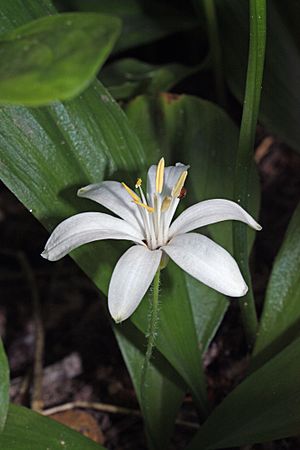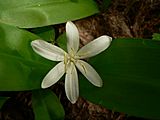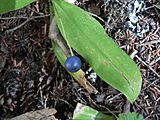Bride's bonnet facts for kids
Quick facts for kids Bride's bonnet |
|
|---|---|
 |
|
| Mount Pilchuck State Park, July 2008 | |
| Conservation status | |
| Scientific classification | |
| Genus: |
Clintonia
|
| Species: |
uniflora
|
| Synonyms | |
|
|
Clintonia uniflora, often called bride's bonnet, queen's cup, or bead lily, is a beautiful flowering plant that belongs to the lily family (Liliaceae). Its scientific name, uniflora, means "one-flowered." This is a special clue because this plant usually has only one flower, which helps tell it apart from other plants in its group, the Clintonia genus. Because of this, it's also known as the single-flowered clintonia.
Contents
About the Plant
Clintonia uniflora is a small plant that lives for many years. It grows from underground stems called rhizomes, which help it spread. It is the smallest plant in its group, usually growing only about 15 to 25 centimeters (6 to 10 inches) tall.
Leaves and Flowers
This plant has two or three leaves at the bottom of its stem. Each leaf is about 2.5 to 6.5 cm (1 to 2.5 in) wide and 8 to 20 cm (3 to 8 in) long.
A Clintonia uniflora plant usually has just one flower. Sometimes, it might have two flowers on its stem. The small flower has six white petals, called tepals, each about 2 cm (0.8 in) long. It also has six white parts called stamens that stick out and are covered with pollen.
Fruit
After the flower is pollinated, it turns into a round, blue berry. This berry is about 1 cm (0.4 in) across.
-
Watercolor painting by Mary Vaux Walcott
-
The solitary flower has six tepals and six stamens.
-
The fruit is a single round blue berry up to a centimeter in diameter.
Plant Names
In 1829, a scientist named Josef August Schultes first described a type of this plant. Later, in 1850, Carl Sigismund Kunth gave it the name Clintonia uniflora, which is what we call it today.
Where It Grows
Clintonia uniflora is found in western North America. It grows from southern Alaska down to central California. You can also find it eastward in southwestern Alberta and northwestern Montana.
Preferred Habitat
This plant likes cool, moist coniferous forests, which are forests with trees like pines and firs. It usually grows at elevations between 3,000 and 5,000 feet (about 900 to 1,500 meters).
It grows in many types of forests. It especially likes forests with trees such as western red cedar (Thuja plicata), western hemlock (Tsuga heterophylla), and different kinds of fir trees like grand fir (Abies grandis). Other plants that often grow near Clintonia uniflora include threeleaf foamflower (Tiarella trifoliata) and twinflower (Linnaea borealis).
Similar Plants
Clintonia uniflora can sometimes be found in the same areas as another plant called C. andrewsiana. However, it's easy to tell them apart. C. uniflora has a single white flower, while C. andrewsiana has many flowers that are a deep red color.
Life Cycle
Clintonia uniflora is a plant that can live for a very long time, sometimes 30 years or even more! It starts to flower between late May and July. After that, its blue berries grow and become ripe from late July to September.
Wildlife and Seeds
While this plant is not a main food source, some animals like birds, elk, and deer do eat it. Birds that eat fruit are important for spreading the plant's seeds. These seeds can stay in the ground and still grow for at least a couple of years.
How People Use It
The indigenous peoples of the Pacific Northwest used Clintonia uniflora in different ways. Groups like the Nuxalk, the Cowlitz, and the Haisla used the plant to help with skin problems and as eye medicine. The Nlaka'pamux people used the ripe blue fruit to make a dye or stain. Today, Clintonia uniflora is also grown in gardens because it is a pretty ornamental plant.
See also
 In Spanish: Clintonia uniflora para niños
In Spanish: Clintonia uniflora para niños





